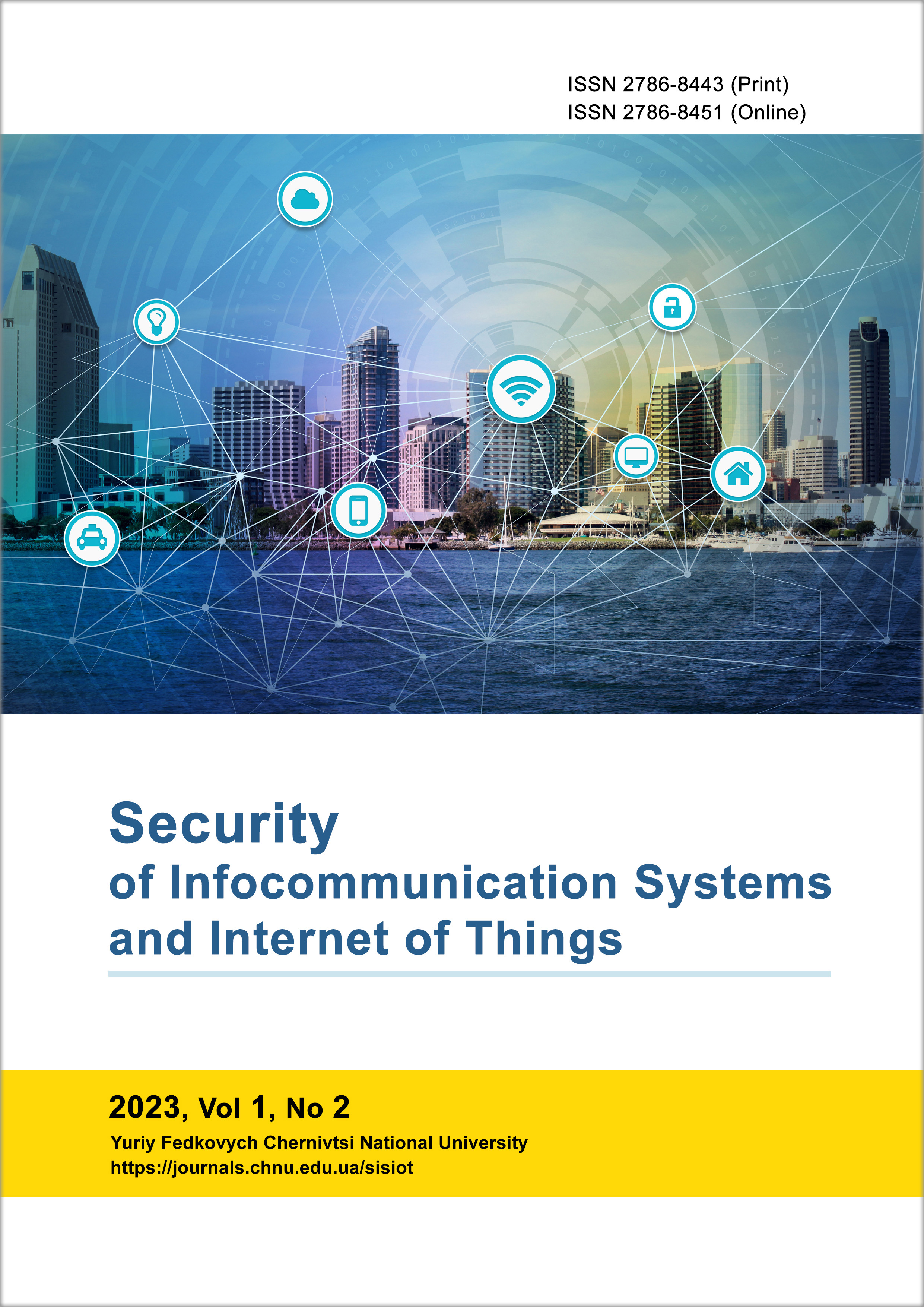Implementing the Search Algorithm of the Correlation Interferometer Direction Finder through the GNU Radio Software Platform
DOI:
https://doi.org/10.31861/sisiot2023.2.02006Keywords:
GNU RADIO, SDR, correlation interferometer algorithmAbstract
In the realm of modern radio equipment development, the integration of Software Defined Radio (SDR) systems, encompassing both software and hardware components, has become widespread. SDR systems, particularly, find applications in the creation of direction finders for radio signal sources. The effectiveness of direction finding and the identification of radio radiation sources largely hinge on the technical specifications of the equipment. For contemporary systems aimed at detecting the location of radio radiation sources, direction finders based on a correlation interferometer prove to be highly suitable. These direction finders excel in performing direction finding for a wide array of radio signals, capable of recognizing broadband modulated signals. They can simultaneously process and identify several signals within a single frequency channel, originating either from a singular source of radio signals (coherent) or from multiple sources (incoherent). SDR technology enables programmable reconfiguration of a radio receiver through software. Such receivers boast a broadband radio frequency component with a significant dynamic range, a high-speed Analog-to-Digital Converter (ADC) path, a robust signal processor, and a specialized digital filtering path. SDR receivers are adaptable to signals of various standards and frequencies, depending on the specific tasks at hand. The GNU RADIO software platform stands out as the most flexible open-source software platform for SDR systems. This article delves into the utilization of the GNU RADIO software platform to implement the search algorithm for the direction finder of the correlation interferometer. The Ettus USRP N210 SDR platform was selected for implementing the direction finder using the correlation interferometer algorithm. This study introduces a two-channel software-controlled model of the direction finder, operating according to the correlation interferometer algorithm. The measurement results for the placement angle of radio signal sources yielded an individual absolute error ranging from 2 to 4 degrees, with an average absolute error of about 3 degrees. These results are quite commendable for such mobile two-channel systems. While systems with four or more channels boast higher accuracy, they tend to have lower economic feasibility.
Downloads
References
Ghaemi K., Ma R., Behdad N.: A Small-Aperture, Ultrawideband HF/VHF Direction-Finding System for Unmanned Aerial Vehicles. IEEE Transactions on Antennas and Propagation 66(10), 2018, 5109–5120 [http://doi.org/10.1109/TAP.2018.2858210].
Liao B, Wen J, Huang L, Guo C, Chan S-C (2016) Direction finding with partly calibrated uniform linear arrays in nonuniform noise. IEEE Sens J 16(12):4882–4890 [DOI: 10.1109/TAP.2011.2173144].
Orduyilmaz A, Kara G, Gürel AE, Serin M, Yildirim A, Soysal G (2018) Real time four channel phase comparison direction finding method. In: 2018 26th signal processing and communications applications conference (SIU). IEEE Press, Izmir, pp 1–4 Design Concepts for Mobile Computing Direction Finding Systems [DOI: 10.1109/SIU.2018.8404590].
Oleksiy Polikarovskykh, Juliy Boiko, Vitalii Tkachuk, Hanna Yehoshyna, Yurii Daus, "Neural Network Method of Directing Finder Signals Processing in Perimeter Protection Systems", 2023 13th International Conference on Advanced Computer Information Technologies (ACIT), pp.488-491, 2023.
Jensen M. A., Mahmood A., Mehmood R.: A compact low-cost direction-finding system for unmanned aerial vehicles. Proceedings of 12th European Conference on Antennas and Propagation EuCAP 2018, London 2018, 1–4 [http://doi.org/10.1049/cp.2018.0983].
Wong K. T., "Direction finding/polarization estimation-dipole and/or loop triad(s)", IEEE Trans. Aerosp. Electron. Syst., vol. 37, no. 2, pp. 679-684, Apr. 2001. [DOI: 10.1109/7.937478].
Lee J-H, Kim J-K, Ryu H-K, Park Y-J (2018) Multiple array spacings for an interferometer direction finder with high direction-finding accuracy in a wide range of frequencies. IEEE Antennas Wirel Propag Lett 17(4):563–566 [DOI: 10.1109/LAWP.2018.2803107].
Mollai S, Farzaneh F (2019) Wideband two-dimensional interferometric direction-finding algorithm using base-triangles and a proposed minimum planar array. AEU-Int J ElectronC 105:163–170 [https://doi.org/10.1016/j.aeue.2019.04.017].
Sobhani G, Pezeshk AM, Behnia F, Sadeghi M (2021) Joint detection of carrier frequency and direction of arrival of wide-band signals using sub-nyquist sampling and interferometric direction finding. AEU—Int J Electron Commun 139:153926 [https://doi.org/10.1016/j.aeue.2021.153926].
GNU Radio. The Free & Open Soft Radio Ecosystem. URL: https://www.gnuradio.org
Stewart R.W., Crockett L., Atkinson D., Barlee K., Crawford D., Chalmers I., et al. A low-cost desktop software defined radio design environment using MATLAB, simulink, and the RTL-SDR //IEEE Communications Magazine. 2015. Vol. 53. Iss. 9. PP. 64–71. [DOI:10.1109/MCOM.2015.7263347].
Wyglinski A.M., Orofino D.P., Ettus M.N., Rondeau T.W. Revolutionizing software defined radio: case studies in hardware, software, and education // IEEE Communications Magazine. 2016. Vol. 54. Iss. 1. PP. 68–75. [DOI:10.1109/MCOM.2016.7378428].
Belisle C., Kovarik V., Pucker L., Turner M. The software communications architecture: two decades of software radio technology innovation // IEEE Communications Magazine. 2015. Vol. 53. Iss. 9. PP. 31–37. DOI:10.1109/MCOM.2015.7263343.
Bilén S.G., Wyglinski A.M., Anderson C., Cooklev T., Dietrich C.B., Farhang-Boroujeny B., et al. Software-Defined Radio: A New Paradigm for Integrated Curriculum Delivery // IEEE Communications Magazine. 2014. Vol. 52. Iss. 5. PP. 184–193. [DOI:10.1109/MCOM.2014.6815911].
Ettus Research. URL: https://www.ettus.com
El-Hajjar M., Nguyen Q.A., Maunder R.G., Ng S.X. Demonstrating the Practical Challenges of Wireless Communications Using USRP // IEEE Communications Magazine. 2014. Vol. 52. Iss. 5. PP. 184–193. [DOI:10.1109/MCOM.2014.6815911].
Stockbroeckx B., Vander Vorst A.: Copolar and cross-polar radiation of Vivaldi antenna on dielectric substrate. IEEE Transactions on Antennas and Propagation 48(1), 2000, 19–25 [http://doi.org/10.1109/8.827381].
Kazici S., Loutridis A., Caratelli D.: A Novel Class of Super-Elliptical Vivaldi Antennas with Enhanced Radiation Properties. IEEE International Symposiumon Antennas and Propagation and USNC-URSI Radio Science Meeting, Atlanta 2019, 259–260 [http://doi.org/10.1109/APUSNCURSINRSM.2019.8888948].
Bilén S.G., Wyglinski A.M., Anderson C., Cooklev T., Dietrich C.B., Farhang-Boroujeny B., et al. Software-Defined Radio: A New Paradigm for Integrated Curriculum Delivery // IEEE Communications Magazine. 2014. Vol. 52. Iss. 5. PP. 184–193. [DOI:10.1109/MCOM.2014.6815911].
Petrova M., Achtzehn A., Mähönen P. System-oriented communications engineering curriculum: teaching design concepts with SDR platforms // IEEE Communications Magazine. 2014. Vol. 52. Iss. 5. PP. 202–209. [DOI:10.1109/MCOM.2014.6815913].
Kim JS, Woong Woo D, Jeong H-C, Choi G-G, Kim SS (2019) A compact radome mounted monopulse antenna for direction-finding applications. In: 2019 IEEE international symposium on antennas and propagation and USNC-URSI radio science meeting. IEEE Press, Atlanta, pp. 2197–2198 [DOI: 10.1109/APUSNCURSINRSM.2019.8888393].
Ko C-B, Lee J-H (2018) Performance of ESPRIT and root-MUSIC for angle-of-arrival (AOA) estimation. In: 2018 IEEE world symposium on communication engineering (WSCE). IEEE Press, Singapore, pp 49–53 [DOI: 10.1109/WSCE.2018.8690541].
Li W, Zhu Z, Gao W, Liao W (2022) Stability and super-resolution of MUSIC and ESPRIT for multi-snapshot spectral estimation. IEEE Trans Signal Process 70:4555–4570 [DOI: 10.1109/TSP.2022.3204454].
Chan YT, Lee BH, Inkol R, Yuan Q (2001) Direction finding with a four-element Adcock-Butler matrix antenna array. IEEE Trans Aerosp Electron Syst 37(4):1155–1162 [DOI: 10.1109/7.976956].
Othman MAB, Belz J, Farhang-Boroujeny B (2017) Performance analysis of matched filter bank for detection of linear frequency modulated chirp signals. IEEE Trans Aerosp Electron Syst 53(1):41–54 [DOI: 10.1109/TAES.2017.2649162].
Abd El-Alim OA, Agrama EE, Ezz-El-Arab ME (1991) Second-order discriminant function for amplitude comparison monopulse antenna systems (EW antenna array). IEEE Trans Instrum Meas 40(3):596–600 [DOI: 10.1109/19.87025].
Bailey M. C., Campbell T. G., Reddy C. J., Kellogg R. L. and Nguyen P., "Compact wideband direction-finding antenna", IEEE Antennas Propag. Mag., vol. 54, no. 6, pp. 44-68, Dec. 2012. [DOI: 10.1109/MAP.2012.6387781].
P. E. Pace, D. Wickersham, D. C. Jenn and N. S. York, "High-resolution phase sampled interferometry using symmetrical number systems", IEEE Trans. Antennas Propag., vol. 49, no. 10, pp. 1411-1423, Oct. 2001. [DOI: 10.1109/8.954930].
J. H. Lee, J. Lee and J. Woo, "Method for obtaining three- and four-element array spacing for interferometer direction-finding system", IEEE Antennas Wireless Propag. Lett., vol. 15, pp. 897-900, 2016. [DOI: 10.1109/LAWP.2015.2479224].
J. H. Lee and J. Woo, "Interferometer direction-finding system with improved DF accuracy using two different array configurations", IEEE Antennas Wireless Propag. Lett., vol. 14, pp. 719-722, 2015. [DOI: 10.1109/LAWP.2014.2377291].
C.-S. Park and D.-Y. Kim, "The fast correlative interferometer direction finder using I/Q demodulator", Proc. Asia-Pac. Conf. Commun., pp. 1-5, 2006. [DOI: 10.1109/APCC.2006.255915].
Published
Issue
Section
License
Copyright (c) 2023 Security of Infocommunication Systems and Internet of Things

This work is licensed under a Creative Commons Attribution 4.0 International License.









